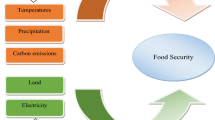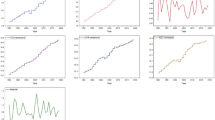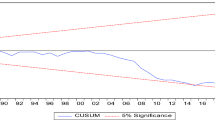Abstract
Food security is a critical global issue, particularly in India, and it is further exacerbated by the challenges posed by climate change. This study aims to examine the influence of climate change on food security in India, utilizing annual time series data spanning from 1994 to 2019. Using the Autoregressive Distributed Lag (ARDL) method, the study investigates the relationship between climate variables, area under cultivation, population growth, agricultural subsidies, and food production. The findings indicate that expanding the cultivation area for food crops significantly enhances food security, with a 1% increase leading to a 2.4% increase in the short run and a 3.2% increase in the long run. Conversely, population growth has a detrimental effect on food security, with a 1% increase resulting in a decline of 3.8% in the short run and 7.8% in the long run. Climate variables also play a crucial role, as rising temperatures adversely impact food security, leading to a decrease of 1.2% in the short run and 1.7% in the long run for every 1% temperature increase. Rainfall, on the other hand, does not significantly affect food security in the long run, but a decrease in rainfall in the preceding period negatively impacts food security in the short run. Furthermore, agricultural subsidies, particularly fertilizer subsidies, impact food security positively in the short run but have adverse effects in the long run. The study highlights the importance of sustainable land management, temperature control measures, water reservation, and effective agricultural subsidies to address food security challenges. These findings provide valuable insights for policymakers in designing effective strategies to ensure food security in India.
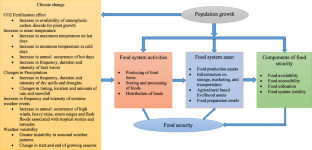


Source: https://vikaspedia.in/agriculture/crop-production/weather-information/agro-climatic-zones-in-india accessed on 13th/June/2023 at 12.03 a.m
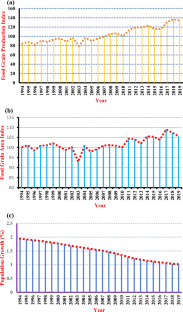


Source: Authors’ computations. CUSUM: cumulative sum. CUSUM SQ: cumulative sum of squares
Similar content being viewed by others
Data availability
The datasets used in the analysis are available in the Indiastat.com, RBI, EPWRPF, and World Development Indicators repository.
Notes
The major crops production such as wheat, rice, maize, and soybean are susceptible to changes in mean air temperature in Southeast Asia (Liu et al., 2020). Similarly, an Indian study predicted a decline of 2.5% in wheat production compared to the base year 2013–14 due to climate change (Amita and Surender 2020). Such reductions in agricultural production are likely to exacerbate food insecurity levels in India.
According to this report, drought-like situations occurred in India during the years 2002–03, 2009–10, 2014–15, and 2015–16 (GOI, 2016). These droughts have led to a decline in food consumption, forcing rural populations in Odisha, India, to adopt co** strategies (Sam et al., 2020). Unfortunately, such co** strategies often contribute to an increase in food insecurity levels.
In fact, approximately 74% of districts in India are affected by this climate variability. Source: https://theprint.in/environment/74-of-indias-districts-prone-to-extreme-climate-like-droughts-floods-cyclones-says-study/756813/ Accessed on 8th /August/2022 at 11.44 p.m.
Furthermore, the report highlights that during the period of 1986–2015, the temperature of the coldest night increased by approximately 0.4%, while the temperature of the warmest day rose by around 0.63% (Krishnan et al., 2020).
The recent Food and Agriculture Organization (FAO) report shows that about 70 percent of the rural population relied on agricultural activities to provide life and livelihood. Besides, the report also revealed that 82 percent of the farmers are small and marginal. These small and marginal farmers often depend on the monsoon because rainfall is the primary water source for irrigation in agricultural activity. Due to natural and anthropogenic activities, climate change likely affected the temperature and rainfall. As a result, there is a chance of adverse impact on the agricultural sector, and hence, food security.
This method can be used for the combination of stationary and non-stationary time series, which is most advantage comparative to the other time series modeling. It provides information on the short-run and long-run impact of the predictors of importance. It is efficient in small samples. Additionally, it also reports the error correction mechanism which shows the speed of adjustment to move from disequilibrium to the equilibrium in the short-run. Due to above importance, the present study used ARDL method to examine our objective.
The information is obtained from https://datahelpdesk.worldbank.org/knowledgebase/articles/906519-world-bank-country-and-lending-groups on 08th/Sept/2022 at 5.23 p.m.
The information is obtained from following website https://www.india.gov.in/india-glance/profile on 08th/Sept/2022 at 4.35 p.m.
The information is obtained from http://cwc.gov.in/sites/default/files/NRLD_04012017.pdf on 30th/Sept/2022 at 6.15 p.m.
The order of integration in time series, denoted as "I(d),” refers to the number of times required to be differentiable to become stationary. Stationarity of time series refers to the certain condition fulfilment such as the mean, variance, and covariance should be time invariant. If the time series is stationary at level, it is represented as I(0) whereas if the time series is stationary at first difference, it is denoted as I(1).
Cointegration between time series refers to the fact that the time series moves together in long-run without the divergency from each other.
References
Abbas, S. (2020). Climate change and cotton production: An empirical investigation of Pakistan. Environmental Science and Pollution Research, 27(23), 29580–29588. https://doi.org/10.1007/s11356-020-09222-0
Abdelzaher, M. A., Farahat, E. M., Abdel-Ghafar, H. M., Balboul, B. A. A., & Awad, M. M. (2023). Environmental policy to develop a conceptual design for the water–energy–food nexus: A case study in Wadi-Dara on the Red Sea Coast. Egypt. Water, 15(4), 780.
AbdelzaherShehata, M. A. N. (2022). Hydration and synergistic features of nanosilica-blended high alkaline white cement pastes composites. Applied Nanoscience, 12(5), 1731–1746.
Ahmad, J., Alam, D., & Haseen, M. S. (2011). Impact of climate change on agriculture and food security in India. International Journal of Agriculture, Environment and Biotechnology, 4(2), 129–137.
Ali, S., Liu, Y., Ishaq, M., Shah, T., Ilyas, A., & Din, I. U. (2017). Climate change and its impact on the yield of major food crops: Evidence from Pakistan. Foods, 6(6), 39.
Amita, R., & Surender, M. (2020). Climate variability and wheat crop yield: Forecasting Indian scenario till 2100 AD. Disaster Advances, 13(11), 31–41.
Arora, N. K. (2019). Impact of climate change on agriculture production and its sustainable solutions. Environmental Sustainability, 2(2), 95–96. https://doi.org/10.1007/s42398-019-00078-w
Auffhammer, M., Ramanathan, V., & Vincent, J. R. (2012). Climate change, the monsoon, and rice yield in India. Climatic Change, 111(2), 411–424. https://doi.org/10.1007/s10584-011-0208-4
Baig, I. A., Ahmed, F., Salam, M. A., & Khan, S. M. (2020). An assessment of climate change and crop productivity in India: A multivariate cointegration framework. TEST Engineering & Management, 83, 3438–3452.
Bandara, J. S., & Cai, Y. (2014). The impact of climate change on food crop productivity, food prices and food security in South Asia. Economic Analysis and Policy, 44, 451–465. https://doi.org/10.1016/j.eap.2014.09.005
Barrios, S., Ouattara, B., & Strobl, E. (2008). The impact of climatic change on agricultural production: Is it different for Africa? Food Policy, 33(4), 287–298.
Benjeddou, O., Ravindran, G., & Abdelzaher, M. A. (2023). Thermal and acoustic features of lightweight concrete based on marble wastes and expanded perlite aggregate. Buildings, 13(4), 992.
Ben Zaied, Y., & Zouabi, O (2015) Climate change impacts on agriculture: A panel cointegration approach and application to Tunisia.
Bhuyan, B., Patra, S., & Bhuian, R. K. (2022). Measurement and determinants of total factor productivity: evidence from Indian banking industry. International Journal of Productivity and Performance Management, 71(7), 2970–2990.
Bhuyan, B., Sahoo, B. K., & Suar, D. (2020a). Food insecurity dynamics in India: A synthetic panel approach. Social Sciences & Humanities Open, 2(1), 100029. https://doi.org/10.1016/j.ssaho.2020.100029
Bhuyan, B., Sahoo, B. K., & Suar, D. (2020b). Nutritional status, poverty, and relative deprivation among socio-economic and gender groups in India: Is the growth inclusive? World Development Perspectives, 18, 1–15. https://doi.org/10.1016/j.wdp.2020.100180
Bhuyan, B., Sahoo, B. K., & Suar, D. (2020c). Quantile Regression Analysis of Predictors of Calorie Demand in India: An Implication for Sustainable Development Goals. Journal of Quantitative Economics., 18, 825–859. https://doi.org/10.1007/s40953-020-00200-4
Bhuyan, B., Patra, S., & Bhuian, R. K. (2020d). Market Adaptability and Evolving Predictability of Stock Returns: An Evidence from India. Asia-Pac Financ Markets, 27, 605–619. https://doi.org/10.1007/s10690-020-09308-2
Birthal, P. S., Khan, T., Negi, D. S., & Agarwal, S. (2014). Impact of climate change on yields of major food crops in India: Implications for food security. Agricultural Economics Research Review, 27(2), 145–155.
Chandio, A. A., Jiang, Y., Rehman, A., & Rauf, A. (2020a). Short and long-run impacts of climate change on agriculture: An empirical evidence from China. International Journal of Climate Change Strategies and Management, 12(2), 201–221.
Chandio, A. A., Ozturk, I., Akram, W., Ahmad, F., & Mirani, A. A. (2020b). Empirical analysis of climate change factors affecting cereal yield: Evidence from Turkey. Environmental Science and Pollution Research, 27(11), 11944–11957.
Chandio, A. A., Jiang, Y., Amin, A., Ahmad, M., Akram, W., & Ahmad, F. (2023). Climate change and food security of South Asia: Fresh evidence from a policy perspective using novel empirical analysis. Journal of Environmental Planning and Management, 66(1), 169–190.
Choudhary, B. B., & Sirohi, S. (2022). Understanding vulnerability of agricultural production system to climatic stressors in North Indian Plains: a meso-analysis. Environment, Development and Sustainability, 24, 13522–13541.
Das, M. K., & Patra, S. (2016a). Productivity and Efficiency of Public Sector Banks in India After the Global Financial Crisis. IUP Journal of Bank Management, 15(2).
Das, M. K., & Patra, S. (2016b). Productivity and efficiency of private sector banks after global financial crisis: evidence from India. Asian Journal of Research in Banking and Finance, 6(5), 1–14.
Datta, P., & Behera, B. (2022). Climate change and Indian agriculture: A systematic review of farmers’ perception, adaptation, and transformation. Environmental Challenges, 8, 100543.
Demeke, A. B., Keil, A., & Zeller, M. (2011). Using panel data to estimate the effect of rainfall shocks on smallholders food security and vulnerability in rural Ethiopia. Climatic Change, 108(1), 185–206. https://doi.org/10.1007/s10584-010-9994-3
Dethier, J.-J., & Effenberger, A. (2012). Agriculture and development: A brief review of the literature. Economic Systems, 36(2), 175–205.
Dumrul, Y., & Kilicaslan, Z. (2017). Economic impacts of climate change on agriculture: Empirical evidence from ARDL approach for Turkey. Journal of Business Economics and Finance, 6(4), 336–347.
Elkhouly, H. I., Abdelzaher, M. A., & El-Kattan, I. M. (2021). Experimental and modeling investigation of physicomechanical properties and firing resistivity of cement pastes incorporation of micro-date seed waste. Iranian Journal of Science and Technology, Transactions of Civil Engineering, 46, 2809–2821.
FAO WFP and IFAD. (2012). The State of Food Insecurity in the World: Economic growth is necessary but not sufficient to accelerate reduction of hunger and malnutrition. Food and Agriculture Organization of the United Nations. http://www.fao.org/3/a-i3027e.pdf
FAO. (1996). World Food Summit. http://www.fao.org/3/w3613e/w3613e00.htm. Accessed 8 December 2019
FAO. (2008). Climate change and food security: a framework document. FAO, Rome
FAO. (2015). The State of Food Insecurity in the World 2015. http://www.fao.org/3/a-i4646e.pdf
GOI. (2016). Manual for Drought Management. https://agricoop.nic.in/sites/default/files/Manual Drought 2016.pdf. Accessed 8 Aug 2023
Grivins, M., Thorsøe, M. H., & Maye, D. (2021). Financial subjectivities in the agricultural sector: A comparative analysis of relations between farmers and banks in Latvia, Denmark and the UK. Journal of Rural Studies, 86, 117–126.
Guntukula, R. (2020). Assessing the impact of climate change on Indian agriculture: Evidence from major crop yields. Journal of Public Affairs, 20(1), 1–7. https://doi.org/10.1002/pa.2040
IPCC. (2014). Climate Change 2014: Synthesis Report. Contribution of Working Groups I, II and III to the Fifth Assessment Report of the Intergovernmental Panel on Climate Change [Core Writing Team, R.K. Pachauri and L.A. Meyer (eds.)]. IPCC, Geneva, Switzerland.
Janjua, P. Z., Samad, G., & Khan, N. (2014). Climate change and wheat production in Pakistan: An autoregressive distributed lag approach. NJAS - Wageningen Journal of Life Sciences, 68, 13–19. https://doi.org/10.1016/j.njas.2013.11.002
Khatri, N., & Tyagi, S. (2015). Influences of natural and anthropogenic factors on surface and groundwater quality in rural and urban areas. Frontiers in Life Science, 8(1), 23–39. https://doi.org/10.1080/21553769.2014.933716
Kotir, J. H. (2011). Climate change and variability in Sub-Saharan Africa: A review of current and future trends and impacts on agriculture and food security. Environment, Development and Sustainability, 13(3), 587–605. https://doi.org/10.1007/s10668-010-9278-0
Krishnan, R., Sanjay, J., Gnanaseelan, C., Mujumdar, M., Kulkarni, A., & Chakraborty, S. (2020). Assessment of climate change over the Indian region: a report of the ministry of earth sciences (MOES), government of India. Springer.
Kumar, S. (2021). Sources and determinants of agricultural growth in Uttar Pradesh: Agro-climatic zone level analysis. Indian Journal of Economics and Development, 17(3), 534–543.
Kumar, S., & Upadhyay, S. K. (2019). Impact of climate change on agricultural productivity and food security in India: A State level analysis. Indian Journal of Agricultural Research, 53(2), 133–142.
Kumar, A., Ahmad, M. M., & Sharma, P. (2017). Influence of climatic and non-climatic factors on sustainable food security in India: A statistical investigation. International Journal of Sustainable Agricultural Management and Informatics, 3(1), 1–30.
Kumar, P., Sahu, N. C., Kumar, S., & Ansari, M. A. (2021). Impact of climate change on cereal production: Evidence from lower-middle-income countries. Environmental Science and Pollution Research, 28(37), 51597–51611. https://doi.org/10.1007/s11356-021-14373-9
Kumar, & Sharma, P. (2013). Impact of climate variation on agricultural productivity and food security in rural India (No. 2013–43).
Liu, D., Mishra, A. K., & Ray, D. K. (2020). Sensitivity of global major crop yields to climate variables: A non-parametric elasticity analysis. Science of the Total Environment, 748, 141431. https://doi.org/10.1016/j.scitotenv.2020.141431
Lobell, D. B., Schlenker, W., & Costa-Roberts, J. (2011). Climate trends and global crop production since 1980. Science, 333(6042), 616–620.
Loum, A., & Fogarassy, C. (2015). The effects of climate change on cereals yield of production and food security in Gambia. Applied Studies in Agribusiness and Commerce, 9(4), 83–92.
Mohanty, R. K., Panda, S., & Bhuyan, B. (2020). Does defence spending and its composition affect economic growth in India? Margin, 14(1), 62–85. https://doi.org/10.1177/0973801019886486
Mozumdar, L. (2012). Agricultural productivity and food security in the develo** world. Bangladesh Journal of Agricultural Economics, 35(454-2016–36530), 53–69.
Muttreja, P., & Singh, S. (2018). Family planning in India: The way forward. The Indian Journal of Medical Research, 148(Suppl 1), S1.
Onour, I. (2019). Effect of carbon dioxide concentration on cereal yield in Sudan. Management and Economics Research Journal, 5(S3), 7.
Owaid, K. A., Hamdoon, A. A., Matti, R. R., Saleh, M. Y., & Abdelzaher, M. A. (2022). Waste polymer and lubricating oil used as asphalt rheological modifiers. Materials, 15(11), 3744.
Patra, S., & Hiremath, G. S. (2022). An Entropy Approach to Measure the Dynamic Stock Market Efficiency. Journal of Quantitative Economics, 20(2), 337–377.
Pesaran, M. H., Shin, Y., & Smith, R. J. (2001). Bounds testing approaches to the analysis of level relationships. Journal of Applied Econometrics, 16(3), 289–326. https://doi.org/10.1002/jae.616
Praveen, B., & Sharma, P. (2020). Climate change and its impacts on Indian agriculture: An econometric analysis. Journal of Public Affairs, 20(1), e1972.
Rao, C. A. R., Raju, B. M. K., Rao, A. V. M. S., Rao, K. V., Rao, V. U. M., Ramachandran, K., et al. (2016). A district level assessment of vulnerability of Indian agriculture to climate change. Current Science, 110(10), 1939–1946.
Ray, L. K., Goel, N. K., & Arora, M. (2019). Trend analysis and change point detection of temperature over parts of India. Theoretical and Applied Climatology, 138(1), 153–167. https://doi.org/10.1007/s00704-019-02819-7
Rohini, P., Rajeevan, M., & Srivastava, A. K. (2016). On the variability and increasing trends of heat waves over India. Scientific Reports, 6(1), 26153. https://doi.org/10.1038/srep26153
Saha, A., Ghosh, S., Sahana, A. S., & Rao, E. P. (2014). Failure of CMIP5 climate models in simulating post-1950 decreasing trend of Indian monsoon. Geophysical Research Letters, 41(20), 7323–7330.
Sam, A. S., Padmaja, S. S., Kächele, H., Kumar, R., & Müller, K. (2020). Climate change, drought and rural communities: Understanding people’s perceptions and adaptations in rural eastern India. International Journal of Disaster Risk Reduction, 44, 101436. https://doi.org/10.1016/j.ijdrr.2019.101436
Sarker, M. A. R., Alam, K., & Gow, J. (2014). Assessing the effects of climate change on rice yields: An econometric investigation using Bangladeshi panel data. Economic Analysis and Policy, 44(4), 405–416. https://doi.org/10.1016/j.eap.2014.11.004
Sharma, S., & Mujumdar, P. (2017). Increasing frequency and spatial extent of concurrent meteorological droughts and heatwaves in India. Scientific Reports, 7(1), 15582. https://doi.org/10.1038/s41598-017-15896-3
Singh, G. (2016). Climate change and food security in India: Challenges and opportunities. Irrigation and Drainage, 65, 5–10.
Singh, N. P., Singh, S., Anand, B., & Ranjith, P. C. (2019). Assessing the impact of climate change on crop yields in Gangetic Plains Region India. Journal of Agrometeorology, 21(4), 452–461.
SinghBhuyan, K. B. (2016). Estimating Taylor type rule for India’s monetary policy using ARDL approach to co-integration. Indian Journal of Economics and Development, 12(3), 515–520.
Timmer, C. P. (1995). Getting agriculture moving: do markets provide the right signals? Food policy, 20(5), 455–472.
Tokunaga, S., Okiyama, M., & Ikegawa, M. (2015). Dynamic panel data analysis of the impacts of climate change on agricultural production in Japan. Japan Agricultural Research Quarterly, 49(2), 149–157. https://doi.org/10.6090/jarq.49.149
Warsame, A. A., Sheik-Ali, I. A., Ali, A. O., & Sarkodie, S. A. (2021). Climate change and crop production nexus in Somalia: An empirical evidence from ARDL technique. Environmental Science and Pollution Research, 28(16), 19838–19850.
Zhao, C., Liu, B., Piao, S., Wang, X., Lobell, D. B., Huang, Y., et al. (2017). Temperature increase reduces global yields of major crops in four independent estimates. Proceedings of the National Academy of Sciences, 114(35), 9326–9331.
Author information
Authors and Affiliations
Contributions
BB was involved in conception and design, data collection and analysis, first draft of the manuscript and revision. RKM contributed to data collection and analysis and provided comments to improve the manuscript. SP was involved in conception and design, drafting and provided comments to improve the manuscript. All authors read and approved the final manuscript.
Corresponding author
Ethics declarations
Conflict of interest
We have no conflicts of interest to disclose.
Additional information
Publisher's Note
Springer Nature remains neutral with regard to jurisdictional claims in published maps and institutional affiliations.
Rights and permissions
Springer Nature or its licensor (e.g. a society or other partner) holds exclusive rights to this article under a publishing agreement with the author(s) or other rightsholder(s); author self-archiving of the accepted manuscript version of this article is solely governed by the terms of such publishing agreement and applicable law.
About this article
Cite this article
Bhuyan, B., Mohanty, R.K. & Patra, S. Impact of climate change on food security in India: an evidence from autoregressive distributed lag model. Environ Dev Sustain (2023). https://doi.org/10.1007/s10668-023-04139-3
Received:
Accepted:
Published:
DOI: https://doi.org/10.1007/s10668-023-04139-3


